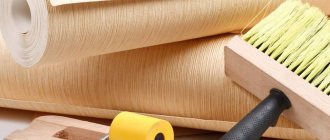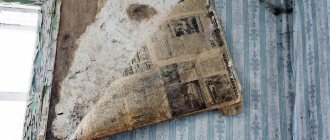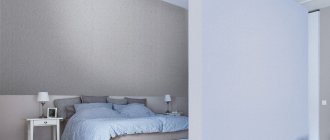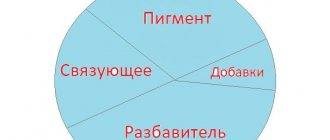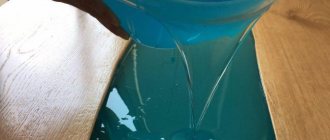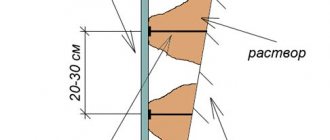Furniture
Modern practical life often does not allow throwing away old high-quality pieces of furniture that have long lost their appearance. Using leftover wallpaper will allow you to embellish old things, make them more interesting and beautiful. There are more than enough master classes showing how to do this on the Internet, open the video hosting and watch
Each designer considers it his duty to publish a video about how he creates an exclusive item from old trash using leftover wallpaper.
Using wallpaper you can decorate: tables, chairs, cabinets, beds, chests of drawers, shelves and any other furniture.
Create an accent in a room with a wallpapered closet
Work is carried out according to the following scheme:
- The first step is to prepare the surface for wallpapering. Most often, furniture is varnished, so we need to sand this varnish. If we are not satisfied with the quality of the surface after treatment, or we need to make the item in a different color, then we paint it.
- Next, we paste the remaining wallpaper in the originally intended order and decorate it. For these purposes, it is best to use not classic wallpaper glue, but something stronger, for example, PVA glue.
- We wait for the wallpaper on the item to dry completely and coat the top with varnish to consolidate the result and give the surface a glossy effect.
Related article: Characteristics of drip irrigation, description of its constituent elements
Wallpapered chest of drawers
As you can see, there is nothing complicated, but the process is quite labor-intensive and time-consuming, especially at the stage of preparatory work.
Wallpaper paintings under glass
It is best to hide under glass compositions made from fabric and paper wallpaper, as well as paintings with details made from fragile materials that require careful care and are not resistant to washing:
- threads;
- ribbons and lace;
- dried flowers and herbarium;
- glitter and colored sand.
For example, you can make an unusual picture for the hallway, corridor or kitchen with the image of a vase. It is necessary to paste the silhouette of a flowerpot onto a background of fabric wallpaper. You can decorate the composition with dry herbs, unusually shaped branches, and dried inflorescences.
It is better to prepare flowers for decoration under pressure so that they are as flat as possible.
Photo wallpaper can also become a special touch in the interior design of a home. This decor looks impressive in the bedroom and living room. Wallpaper can be placed either in one large photo frame or in several small ones, having previously thought out a modular composition.
Covering old furniture with paper trellises is a godsend for those who adore Provençal motifs in design. With the help of excess finishing materials, you can create an original piece of furniture that will become the center of the decoration concept.
The technique for decorating a set is similar to decoupage, but does not require soaking the wallpaper with water. To glue wallpaper patches, you need to properly prepare the set.
- Clean the surface of the furniture from varnish and old paint.
- Get rid of cracks using putty.
- To obtain a perfectly smooth surface, treat it with sandpaper.
- Prime the work area with acrylic primer.
You can paste leftover wallpaper not only on the façade of furniture. For example, manufacturers often pay little attention to the internal surface of the headset. To create an original and stylish decor, simply glue wallpaper to the back wall of the sideboard. To improve the wear resistance of the material, additionally coat the surface with two layers of varnish.
Furniture decorated with bamboo wallpaper looks original. This set will fit perfectly into an oriental-style interior. For the Scandinavian trend, trellises with imitation of natural stone or spectacular wood are suitable.
Extra wallpaper - paintings on the walls
If you decide to make paintings from wallpaper and decorate the walls of your apartment or house with them, then take this very seriously and responsibly. This process is quite simple, but it will require maximum accuracy and precision from you. This meticulousness will help you see the creative idea on your wall and will not give the impression that you did not have enough wallpaper.
Wallpaper-paintings for walls are very easy to make. By evaluating the available material, using imagination and special care in making paintings, you will get an excellent result on your wall.
Think about the size of the paintings and their number in advance. This can be a large panel covering the entire wall, or a large number of small pictures made in the same theme, or two or three medium-sized paintings in harmony with each other. Determine the location of your future product, evaluate its combination with the overall appearance of the room and get to work.
If you decide to decorate a wall in an apartment or house with wallpaper, you need to take it seriously
Procedure for creating a picture from wallpaper:
- From the leftover wallpaper, select the most suitable size and cut out the design you like;
- Glue the cut out figure onto a large, thick, plain sheet of paper;
- Smooth the painting well and carefully and let it dry completely;
- Place the resulting composition in a suitable frame.
Read also: Do-it-yourself wood putty: manufacturing technology
The frame is also an important decorative element. When choosing a frame for your works, consider the overall design direction of the room. A picture without a frame also looks pretty good on the wall, but in this case it will not please you for too long, and will soon become unusable.
Walls
The easiest way to use leftover wallpaper is to make some kind of accent on one of the walls. If classic plain wallpaper was used when decorating the room, this is very easy to do. Select a small section of the wall and add companion wallpaper from the collection there, or some contrasting wallpaper that will clearly stand out.
In this way you will add some zest to your interior, and also use some of the remaining canvases.
Non-standard design techniques
However, in this case, there is a possibility of going too far and ruining the interior; the danger lies in two key points:
- The accent area should be small, approximately it should occupy 5-10% of the total area of the walls, then it will look advantageous. If you do additional gluing in large proportions, there is a possibility of creating a tasteless interior.
- The second difficulty is choosing a color. Even when using contrasting colors, it is worth finding out how compatible they are. It is very good to use similar wallpapers from the same collection, but in a different color.
Related article: How to clean a pool or pond from blooming water or mechanical impurities
Border
If you used striped wallpaper in your work, then there is an excellent opportunity to use the remains as a wallpaper border. Wallpaper borders are most often used to zone space in a room, highlight an area of a pattern on a wall or a wallpaper panel, as well as to outline the contours of a ceiling or baseboard.
A strip of wallpaper can be of different widths
Why did we talk about striped wallpaper in the first place? It’s just easier to make a wallpaper border out of them by cutting along the line. Wallpaper with a pattern can also be cut into strips, but doing it exactly is very problematic.
Bedside area
High-quality vinyl wallpaper, which is not afraid of any contamination and can be thoroughly washed with water, can be used in the bedside area at the head of the bed. This place is often exposed to human contact, and as a result gradually gets dirty. By gluing vinyl wallpaper there, you can not only decorate this area, but also make it as practical as possible.
Using high-quality wallpaper of various types in areas near the bed
It is permissible to use almost any similar options, and in case of a strong discrepancy, you can delineate the area with a wallpaper border ready-made or of your own production.
Decorative panel
If you used interesting colorful wallpaper in your interior, but after the renovation it remained, then you can make a picture or panel out of it and paste it in a room where the wallpaper is simple or plain.
Creating a panel is quite simple; the best option is to use the current wallpaper pattern, or make a kind of mosaic out of it, gluing pieces of wallpaper onto the canvas in any form. You are unlikely to get a full-fledged picture, so it is recommended to use abstract motifs.
An example of creating several panels in one room
Having pasted such a canvas on the wall, it must be highlighted. The easiest way to do this is with white molding, which comes in different widths. If you want to create something more elegant, then the frame can be made of wood.
Related article: Tips for covering the ceiling with wallpaper for painting
Polluted places
If the repair work was accompanied by gluing vinyl wallpaper on a non-woven backing with excellent practical properties, some of the wallpaper remained. It is recommended to use these residues to enhance the protection of easily soiled areas of the walls, for example in the hallway or kitchen.
There are always places in the apartment where there is frequent human contact with the wallpaper, as a result of which it gets very rubbed and dirty. Of course, strong, washable vinyl wallpaper is ready for this, but still, over time, its texture deteriorates. Additional gluing of high-quality wallpaper will help hide already worn areas and protect new ones.
Using durable vinyl wallpaper in the hallway
With the remains of wallpaper you can decorate not only the walls, but also the furniture in the apartment.
Idea #1: combination
If you have large panels or entire rolls of wallpaper unclaimed, you can try combining them. At the same time, glue the pieces:
- vertically
_ This method of inserts allows you not only to update the interior using leftover wallpaper, but also to accentuate certain areas of the room. Zoning the room.
The remaining rolls of wallpaper can be pasted onto the prepared walls, and it doesn’t matter, there are few of them - it looks stylish. Even if you only have one roll of wallpaper left, it can be effectively used in the interior
- Vertically pasted patterned stripes, in combination with a monochromatic wall, can visually increase the height of the ceilings and impart a certain dynamism to the atmosphere. Selected textiles and decorative elements will help to emphasize the achieved effect.
This is how you can combine patterned wallpaper and a plain painted wall
- horizontally
. In this case, it is best to combine patterned and plain wallpaper. To create a complete composition, the horizontal joint line must be trimmed with a border that visually unites both materials used. By the way, in this case, decor with the remains of striped wallpaper can serve as such a separator.
Horizontal combination of two types of wallpaper: with a small pattern and plain This is what a horizontal combination of the remaining wallpaper looks like horizontally: striped and plain wallpaper
